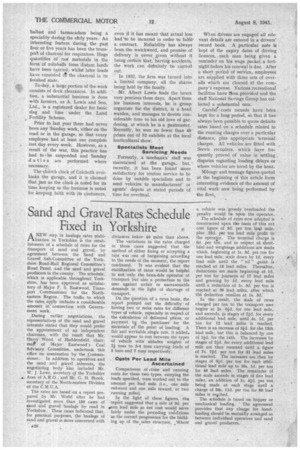Sand and Gravel Rates Schedule Fixed in Yorkshire
Page 28

If you've noticed an error in this article please click here to report it so we can fix it.
ANEW step in haulage rates stabilizationization in Yorkshire is the establishment of a schedule of rates for the transport of sand and gravel, by agreement between the Sand and Gravel Sub-Committee of the Yorkshire Road-Rail Regional Committee's Road Panel, and the sand and gravel producers in the county. The schedule, which is applicable throughout Yorkshire, has been approved as satisfactory of Major F. S. Eastwood, Transport Commissioner for the Northeastern Region. The traffic to which the rates apply includes a considerable amount in connection with Government work.
_During earlier negotiations, the representatives of the sand and gravel interests stated that they would prefer the appointment of an independent chairman, with the result that Mr. Harry Wood, of Huddersfield, chairma!? of Major Eastwood's Coal Advisory Committee, undertook this office on nomination by the Commissioner. in addition to operators and the sand and gravel interests, the negotiating body 'also included Mr. W. J. Lowe, secretary of the Yorkshire Area of A.R.O., and Mr. G. H. Brook, secretary of the North-eastern Division of the C.M.U.A.
The rates are based on a report prepared by Mr. Wo6d after he had investigated more than .150 cases of sand and gravel haulage by road in Yorkshire. These cases indicated that, for practical purposes, the haulage of sand and gravel is more concerned with
distances below 40 miles than above.
The variations in the rates charged in these cases suggested that the method of either fixing or accepting a rate was one of bargaining according to the needs of the moment, the report continued. It was evident that the stabilization of rates would be helpful to not only the bona-fide operator of transport but also a protection to the user against unfair or unreasonable demands in the light of shortage of transport.
On the question of a rates basis, the report pointed out the difficultyof having two or more rates for different types cif vehicle,. especially in respect of the -calculation of delivered pfices, or payment blf the purchaser for the materials at the point of loading. A fair and workable single rate, it added,. would appear to rest between the types of vehicle with unladen weights of 21 tons to 3-4 tons carrying loads of 5 tons and 7 tons respectively.
Casts Per Lead Mlle Ascertained
Comparisons of Anne and running costs for these two types, carrying the loads specified, were worked out to the amount per lead mile (i.e., one mile outward and one mile inward, or two running miles).
In the light of these figures, the report suggested that a rate of 3d. per *ton lead mile as net cost would serve fairly under the preceding caditions as the correct progression 'for the building up of the rates structure. .Where a vehicle was grossly overloaded the penalty would be upon the operator.
The schedule of rates now adopted is constructed upon the basis ofthis net cost figure of 3d. per ton le* mile, plus .25d. per ton lead mile profit to the operator. The terminal charge is 6.d. per ton, and in respect of shortMu' and weightage additions are made which, beginning at Is. 3d. per ton for one lead mile, scale down by Id. every
lead mile until the nil " point is reached at 16 lead miles. Thereafter, deductions are made beginning at Id. per ton for journeys of 17 lead miles and growing by id. every lead mile until a reduction of Is. 3d. per .ton is reached at 30 lead miles, after which tire' deduction remains at Is. 3d. .
In the. result, the kale of rates charged per ton to the transport. user begins at 2s. Old. for one lead mile, and ascends, in stages of 2id. for every additional lead mile," until 4s. Id. per ton for 12 lead miles is reached. There is an increase of 83d. for the 13th lead. mile, but this is balanced by one of lid. for the 14th. The increases by stages of 21d. for every additional lead mile arc then resumed until a figure of 7s. 73d. per ton for 81 lead miles is reached. The increases are then by stages of 3.1d. per ton for 'each arldiL tional lead mile up to 10s. Id. per ton for 40 lead miles. The remainder of the scale ascends in stages of five lead miles, an addition of Is. 4id. per ton. being made at each stage until a charge of 20s. lid, per ton for 80 lead miles is reached.
The schedule is based on hopper or mechanical loading. " The agreement provides that any charge for handloading should be mutually arranged as between individual operators and sand and gravel producers. .




















































